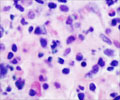New study utilized microfluidics technology to develop a device able to isolate cancer cells from the urine of patients with prostate cancer.

It's not easy to gain a significant decrease of mortality rate because there is no practical or accurate enough method of diagnosis able to detect the disease in its early stage.
Nowadays, two methods are usually used to prove the diagnosis: the prostate-specific antigen (PSA) blood test and the tissue biopsy - taking the tissue samples for analysis. Both of these methods have significant drawbacks. A blood test is not specific enough and can produce false-positive results since the PSA level rises not only in the case of prostate cancer but also during other diseases of the prostate gland. Tissue biopsy is an invasive examination that can cause adverse side e?ects such as local bleeding and infections. Also, as previous studies have shown, the sensitivity of liquid blood biopsy (isolating cancer cells) is rather poor because of the low level of the cells in the blood. So, scientists suggest an alternative that is a liquid urine biopsy: the prostate gland is closely connected with the urethra and cancer cells are washed out during urination.
"As we have shown while testing this technique, we managed to collect 85 (±6) % of the total number of prostate cancer cells as well as to isolate cells from the urine of 86% of patients with localized cancer in the early stage. Now we are trying to optimize the method to improve its efficacy, specificity, and sensitivity while the technology itself is going through the patent process," said Alexey Rzhevskiy, a research associate in the Institute of Molecular Medicine, Sechenov University.
To isolate cells from the liquid, researchers developed a micro? uidic chip - a device made from polymer with a thin spiral channel, forked on one end, and three holes: one for urine intake and two for cell separation. The chip is so designed that cancer cells that are larger than others shift to the inner wall of the channel and leave it through one of the holes while smaller and lighter cells gather along the outer wall and come out through the other hole. This effect is caused by the joint action of several centrifugal forces.
Scientists labeled the collected cells with uorescent antibodies - molecules able to glow while absorbing light of a certain wavelength. Researchers examined cancer cells with the antibodies under a fluorescence microscope and measured the intensity of the light emitted: if it exceeded the calculated threshold, scientists concluded that these cells were cancerous.
Advertisement
Source-Eurekalert








![Prostate Specific Antigen [PSA] Prostate Specific Antigen [PSA]](https://www.medindia.net/images/common/patientinfo/120_100/prostate-specific-antigen.jpg)






